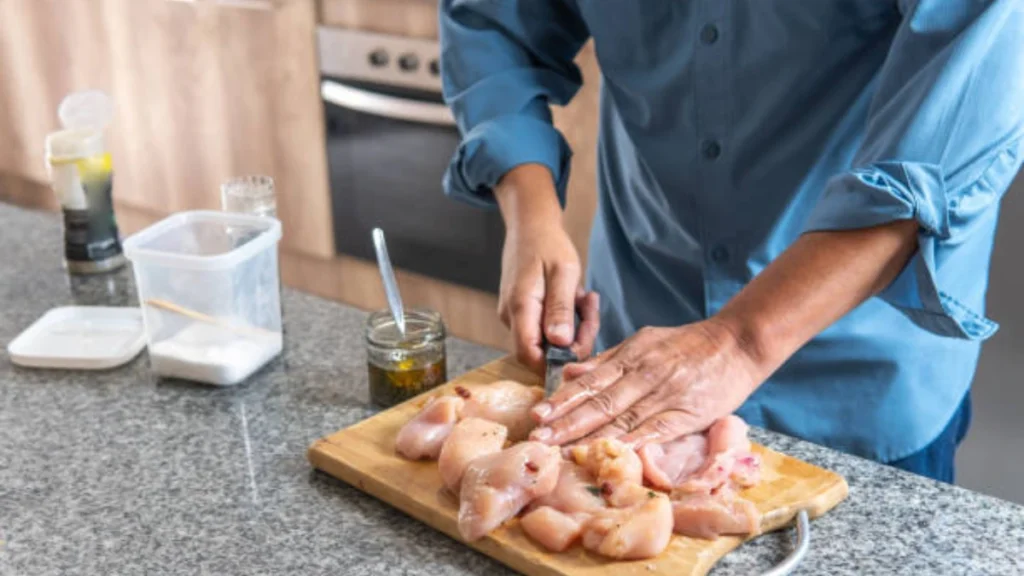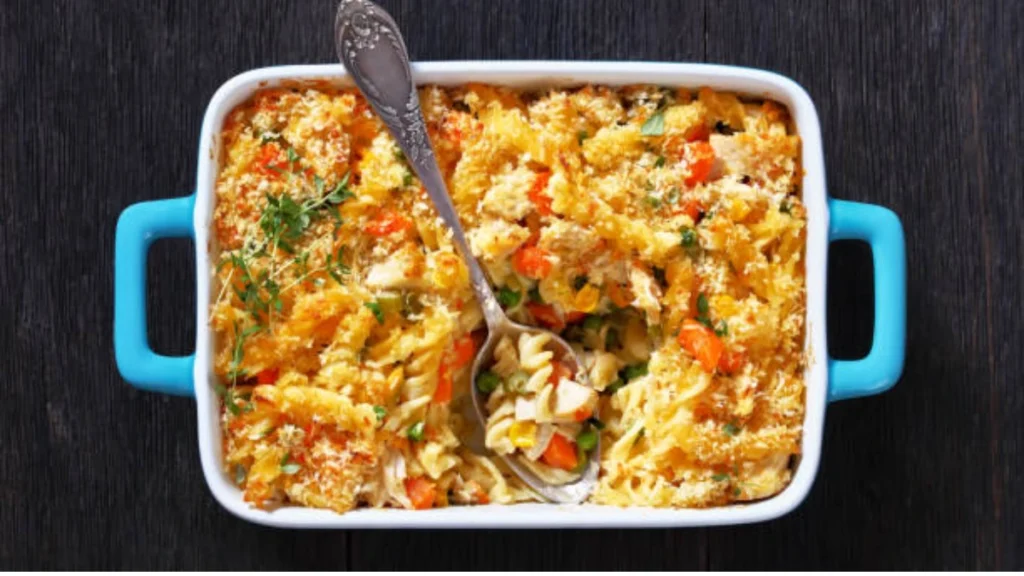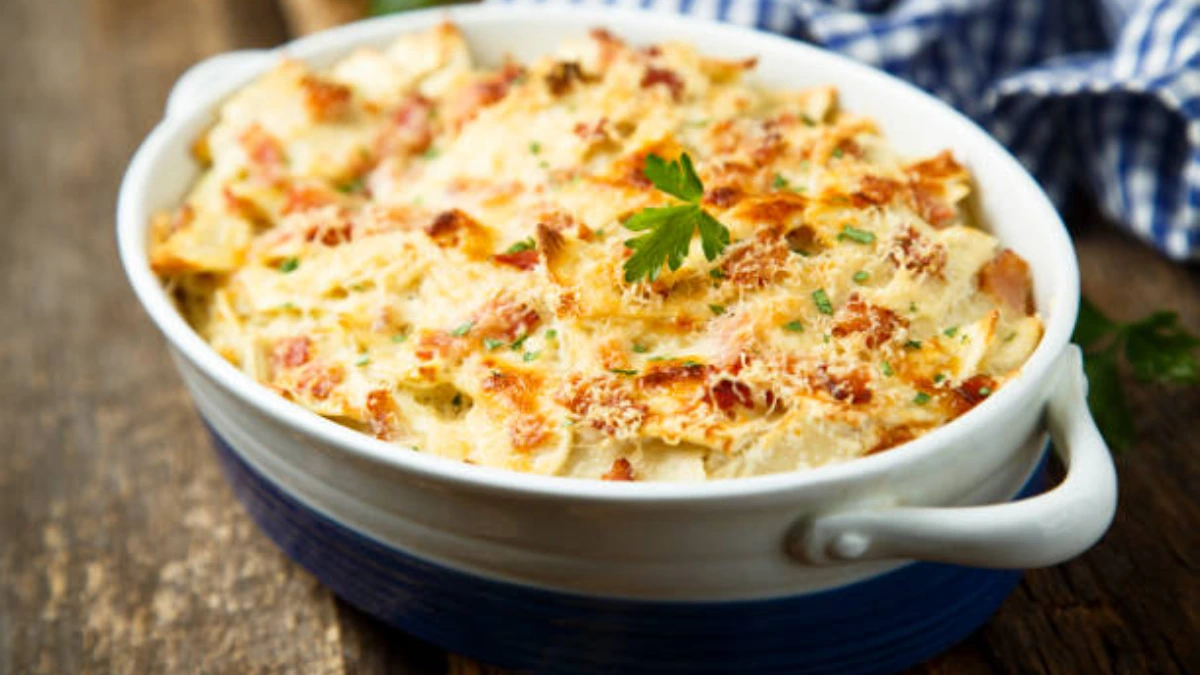Introduction: Why Garlic Parmesan Chicken Pasta Casserole is the Ultimate Comfort Food
When it comes to comfort food, few dishes can compete with the warm, creamy richness of a well-made casserole. And when that casserole features the unbeatable combination of garlic, Parmesan, chicken, and pasta, it’s a true winner. Garlic Parmesan Chicken Pasta Casserole brings together all the ingredients we crave—cheesy, savory, and full of flavor—into a single, satisfying dish that’s both filling and indulgent. Whether you’re cooking for a family dinner or preparing a hearty meal after a long day, this casserole is guaranteed to become a favorite. Its simplicity, versatility, and rich flavor profile make it a must-try for any occasion.
What Makes This Recipe So Special?
The Garlic Parmesan Chicken Pasta Casserole stands out for several reasons. Its creamy, cheesy sauce perfectly complements the tenderness of the chicken, while the pasta absorbs all the delicious flavors. The combination of garlic and Parmesan creates a rich, savory foundation that adds depth and character to the dish. Each bite is an explosion of comforting, indulgent flavors.
What makes this dish even more appealing is how effortlessly it comes together. This isn’t a meal that requires hours in the kitchen. With a few simple ingredients and just a little preparation, you can have a mouthwatering casserole ready in no time. The balance of flavors and textures—creamy sauce, tender chicken, al dente pasta, and crispy top—makes this dish something truly special.
This casserole is also perfect for both busy weeknights and larger family gatherings. It’s easy to scale up, and leftovers taste just as amazing, making it an ideal dish to prepare in advance or for meal prepping.
Essential Ingredients for the Perfect Garlic Parmesan Chicken Pasta Casserole
Creating the ultimate garlic Parmesan chicken pasta casserole starts with the right ingredients. While the dish is simple, the quality of each component plays a crucial role in its final taste and texture.
Fresh Chicken Breast: Why It’s the Best Choice for Tenderness
Chicken breast is the go-to choice for this recipe, thanks to its mild flavor and tender texture when cooked properly. Using fresh chicken ensures that the meat remains juicy and succulent, providing the perfect contrast to the rich, cheesy sauce.
Garlic and Parmesan: The Flavor Duo You Can’t Live Without
Garlic and Parmesan are the heart of the flavor profile. Garlic adds a sharp, aromatic undertone, while Parmesan offers a nutty, salty richness that ties everything together. Using freshly grated Parmesan creates a smoother texture and a more intense flavor than pre-shredded cheese.
Pasta Varieties: Choosing the Right Pasta for a Creamy Casserole
Pasta is the backbone of this dish, absorbing the creamy sauce and melding with the chicken. Opt for pasta shapes that hold up well in casseroles, such as penne, rotini, or fusilli. These shapes trap sauce inside and ensure each bite is perfectly coated.
Creamy Sauce: What Makes It Rich and Irresistible
The creamy sauce is what takes this casserole to the next level. Made with a base of butter, cream, and cheese, it’s rich without being overly heavy. The inclusion of heavy cream gives it a velvety smooth texture, while butter and cheese enhance the richness.
Herbs and Spices: Adding Depth and Aroma
A few key herbs and spices bring out the best in this dish. Fresh or dried parsley, thyme, and a pinch of nutmeg or black pepper add layers of flavor without overpowering the main ingredients. These aromatic touches elevate the dish, making it even more comforting.
Toppings and Garnishes: The Secret to a Golden, Crispy Finish
The finishing touches—extra Parmesan, a sprinkling of breadcrumbs, and a drizzle of olive oil—create a beautifully golden, crispy crust. These additions add both texture and a burst of flavor, making every bite a balanced delight.
Step 1: Preparing the Chicken for Maximum Flavor
How to Cook Chicken Breast Perfectly for Casserole
The key to juicy chicken in your casserole lies in proper cooking techniques. Start by seasoning the chicken breasts generously with salt, pepper, and any additional spices you like. Cooking the chicken in a hot pan with butter or oil allows the outside to sear while keeping the inside moist. Alternatively, roasting or poaching are great options for ensuring tender, flavorful chicken that holds up well in the casserole.
Marinating Chicken: Optional but Highly Recommended for Flavor
Though marinating is optional, it can truly enhance the flavor of the chicken. A simple marinade of olive oil, garlic, lemon juice, and herbs will infuse the meat with an extra layer of richness. Marinating for at least 30 minutes will impart subtle yet noticeable flavors to the chicken.
Shredding or Dicing: Which Method Works Best?
While dicing chicken into cubes provides a more structured bite, shredding allows the chicken to absorb more of the creamy sauce. Both methods work well, but shredding gives the casserole a more cohesive texture, as the chicken will mix seamlessly with the pasta and sauce.

Step 2: Cooking the Pasta to Perfection
Al Dente vs. Soft Pasta: The Right Texture for Your Casserole
When cooking pasta for a casserole, aim for al dente—firm to the bite. This prevents the pasta from becoming mushy during baking. While the pasta will continue to cook in the oven, starting with al dente ensures it retains its structure and texture.
The Importance of Seasoning the Pasta Water
Don’t skip seasoning the pasta water. Adding salt to the water enhances the pasta’s natural flavor, ensuring each bite is well-seasoned. It’s a simple yet crucial step that can elevate the dish.
How to Prevent Pasta from Becoming Too Soft or Mushy
To prevent mushy pasta, ensure you cook it for 1-2 minutes less than the package instructions suggest. This allows the pasta to absorb the sauce during baking without becoming overcooked.
Step 3: Creating the Garlic Parmesan Sauce
Why Garlic and Butter Are the Base of the Sauce
Garlic and butter form the rich, aromatic base of the sauce. The butter adds a silky texture, while the garlic imparts a bold, savory depth. Sautéing the garlic in melted butter until fragrant ensures that the garlic’s oils are fully extracted, creating a powerful flavor foundation.
Adding Heavy Cream for the Perfect Consistency
Heavy cream is what gives this sauce its luxurious, smooth texture. Unlike milk, heavy cream has a higher fat content, which makes the sauce creamy and rich. Stirring the cream into the garlic and butter mixture ensures that the sauce coats the pasta and chicken perfectly.
The Magic of Freshly Grated Parmesan Cheese
Freshly grated Parmesan cheese adds both flavor and body to the sauce. As it melts into the cream, it creates a velvety, rich texture that ties the dish together. Pre-grated cheese often lacks the same depth and doesn’t melt as smoothly.
How to Incorporate Other Flavor Boosters Like Cream Cheese or Sour Cream
For an extra creamy twist, consider adding a dollop of cream cheese or sour cream to the sauce. These ingredients add tanginess and a smooth, velvety consistency, elevating the overall dish.
Step 4: Combining the Ingredients
How to Layer the Ingredients for the Best Texture
Layering the casserole properly ensures a uniform distribution of ingredients. Start by placing a layer of pasta at the bottom, followed by a generous portion of chicken and sauce. Repeat the layers, making sure each is well-distributed for consistent flavor and texture.
Mixing the Chicken, Pasta, and Sauce Evenly
It’s essential to mix the chicken, pasta, and sauce evenly to ensure every bite is full of flavor. Gently toss the ingredients together in the casserole dish, making sure the pasta is well-coated with the sauce and the chicken is evenly dispersed.
The Importance of Seasoning as You Combine
Taste the mixture as you combine the ingredients, adjusting seasoning as needed. A little extra salt, pepper, or Parmesan can make a big difference in enhancing the overall flavor.
Step 5: Assembling the Casserole for Even Cooking
Why a Good Casserole Dish Matters
The casserole dish is important for ensuring even cooking. Opt for a dish with a wide base that allows the mixture to spread evenly. A glass or ceramic dish retains heat well, helping the casserole bake uniformly.
How to Properly Spread the Mixture for Even Baking
Once the ingredients are combined, spread them evenly across the dish. A spatula works well to level the surface, ensuring that the casserole cooks uniformly and the top achieves a perfect, golden finish.
Tips for Achieving the Perfect Texture: Creamy Inside, Crispy Top
To achieve the ideal texture, bake the casserole uncovered for the last few minutes of cooking. This will allow the top to crisp up, while the inside remains creamy and rich.
Step 6: Baking for the Perfect Texture and Taste
Oven Temperature: The Right Heat for Perfect Results
Bake your casserole at 350°F (175°C) for the best results. This moderate temperature allows the flavors to meld together while ensuring the pasta and chicken don’t dry out. A too-high temperature may cause the sauce to separate.
Covering vs. Uncovering: When to Do Which for Best Results
Cover the casserole with foil for the majority of the baking time to lock in moisture. Uncover it during the last 10-15 minutes to achieve a crispy, golden top.
How Long to Bake for the Perfect Consistency
Bake for 25-30 minutes, or until the top is golden and bubbly. Check that the casserole is heated through by inserting a knife into the center—if it comes out hot, the casserole is ready.
Checking for Doneness: What to Look For
Look for a golden crust on top and bubbling edges. The sauce should be thick and creamy, and the chicken should be fully cooked, with no pink remaining.
Step 7: Finishing Touches That Make a Difference
Adding Extra Parmesan for a Crispy, Golden Crust
For a perfect finish, sprinkle a little more Parmesan cheese on top before baking. This will melt into a beautiful, golden crust, enhancing both flavor and texture.
Fresh Herbs: Why They Elevate the Dish
Fresh parsley or basil sprinkled over the top just before serving adds a burst of color and a fresh, aromatic contrast to the richness of the casserole.
Drizzling Olive Oil for Added Richness
A light drizzle of olive oil just before serving adds a layer of richness and a silky sheen to the top of the casserole.
Letting the Casserole Rest Before Serving
Allow the casserole to rest for 5-10 minutes after baking. This gives the sauce time to set, making it easier to slice and serve while ensuring the flavors are fully developed.
How to Serve Garlic Parmesan Chicken Pasta Casserole
Side Dishes That Complement the Rich Flavors of the Casserole
Garlic Parmesan Chicken Pasta Casserole pairs wonderfully with a fresh, crisp salad or roasted vegetables. The freshness of a green salad provides a nice contrast to the creamy richness of the casserole, while roasted vegetables add texture and a slight sweetness.
Best Garnishes for a Visually Appealing Presentation
For an attractive presentation, consider adding a sprinkle of fresh herbs, extra Parmesan, or even a light drizzle of balsamic reduction. These garnishes add visual appeal and an extra flavor boost.
Wine Pairings That Enhance the Meal
A crisp white wine, such as Chardonnay or Sauvignon Blanc, complements the rich, cheesy casserole without overpowering it. A light red wine, like Pinot Noir, also pairs beautifully, balancing the dish’s savory flavors.
Make-Ahead Tips for Garlic Parmesan Chicken Pasta Casserole
How to Prepare the Casserole in Advance
Prepare the casserole up to the point of baking, cover it tightly with foil, and refrigerate it for up to 24 hours. This saves time on the day of serving and allows the flavors to meld together more deeply.
Freezing Tips for Long-Term Storage
For longer storage, freeze the prepared casserole before baking. Wrap it tightly in plastic wrap and foil to prevent freezer burn. It will stay fresh for up to three months and can be baked straight from the freezer—just add an extra 15-20 minutes to the baking time.
Reheating Methods That Preserve the Taste and Texture
To reheat, cover the casserole with foil and bake at 350°F for 20-30 minutes. For a crispier top, uncover during the last few minutes of baking.
Variations to Customize Your Garlic Parmesan Chicken Pasta Casserole
Adding Vegetables for More Color and Nutrients
Incorporate vegetables like spinach, broccoli, or bell peppers for added color and nutrition. These vegetables pair wonderfully with the creamy sauce and add depth to the flavor.
Experimenting with Different Pasta Shapes or Types
While penne or fusilli works best, feel free to experiment with other pasta shapes, such as shells or rotini. You can also opt for whole wheat or gluten-free pastahttps://gimarecipes.com/easy-gluten-free-pasta-salad-for-busy-weeknights/ for a healthier or dietary-friendly twist.
Going Gluten-Free: Tips for Adapting the Recipe
To make the casserole gluten-free, swap the pasta for a gluten-free variety and use a gluten-free flour blend to thicken the sauce. This way, everyone can enjoy the delicious flavors.
Spicy Twists: Adding Red Pepper Flakes or Hot Sauce
For those who like a little heat, add red pepper flakes or a splash of hot sauce to the garlic Parmesan sauce. The heat balances the richness and adds a zesty kick.

Why This Recipe is Perfect for Meal Prepping
How It Holds Up Well in the Fridge for Days
Garlic Parmesan Chicken Pasta Casserole is a great meal prep option. It stores well in the fridge for up to 4 days, allowing you to enjoy it for multiple meals.
Portioning Ideas for Easy Reheating
Divide the casserole into individual portions before storing. This makes reheating easier and ensures that each serving is perfectly sized.
Using Leftovers Creatively for Another Meal
Leftover casserole can be repurposed as a filling for wraps or mixed into a salad for a quick lunch the next day. The flavors only improve as they sit, making it an excellent meal prep choice.
Troubleshooting Common Issues in Garlic Parmesan Chicken Pasta Casserole
What to Do if Your Casserole Is Too Dry
If your casserole turns out too dry, add a little more cream or broth to the sauce before baking. You can also drizzle some olive oil over the top to keep the casserole moist.
Fixing a Soggy Casserole
To fix a soggy casserole, avoid overcooking the pasta. Make sure the casserole is evenly layered and try using less sauce next time to prevent excess moisture.
How to Avoid Overcooked Chicken or Pasta
To avoid overcooked chicken, use a thermometer to ensure it reaches 165°F. For pasta, undercook it slightly, as it will continue to absorb moisture while baking.
Conclusion: Enjoying the Perfect Garlic Parmesan Chicken Pasta Casserole
This Garlic Parmesan Chicken Pasta Casserole is destined to become a staple in your recipe collection. Its rich, savory flavors and simple preparation make it the perfect comfort food for any occasion. The beauty of this dish lies in its versatility—you can easily make it ahead of time, customize it to suit your taste, and enjoy it for days. Whether you’re serving it to guests or enjoying it as a quick weeknight dinner, this casserole will impress with its hearty, satisfying flavors.
FAQS
What’s the difference between chicken Parmesan and chicken parmigiana?
Chicken Parmesan” and “Chicken Parmigiana” refer to the same dish: breaded chicken cutlets topped with tomato sauce and melted cheese. The main difference lies in the terminology. “Parmigiana” is the original Italian term, meaning “in the style of Parma,” the region famous for Parmesan cheese, while “Parmesan” is the anglicized version commonly used in the United States. Technically, “Chicken Parmigiana” is the correct term, but most people simply call it “Chicken Parmesan.”
Does Parmesan go well with pasta?
Yes, Parmesan pairs exceptionally well with pasta! Its rich, nutty, and salty flavor enhances the taste of pasta dishes, whether served as a topping or mixed into sauces. A classic example is Pasta with Butter and Parmesan, which is loved for its simplicity and universal appeal. This dish can also serve as a base for endless variations, allowing you to customize it with additional ingredients like herbs, garlic, or vegetables. Parmesan’s versatility makes it a staple in many pasta
What makes chicken soggy?
Chicken can turn out soggy for several reasons, with one of the most common being improper frying techniques. If the oil temperature drops below the ideal frying level—around 350°F or slightly higher—the chicken will absorb more oil instead of crisping up, leading to a greasy and soggy texture. Other factors can include overcrowding the pan, which lowers the oil temperature, or not properly patting the chicken dry before breading, which prevents a crispy exterior. Ensuring the oil stays at the right temperature and avoiding excess moisture are key to achieving perfectly crispy chicken.


3 thoughts on “7 Easy Steps to Perfect Garlic Parmesan Chicken Pasta Casserole”